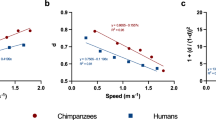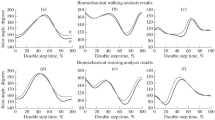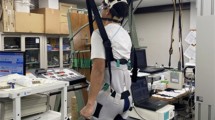Abstract
It seems reasonable that quadrupeds should change gait from a walk to a trot to a gallop in such a way as to minimize their energy consumption, as human beings are known1 to change from a walk to a run at a particular speed (2.4 m s−1) below which walking requires less energy than running and above which the opposite is true. Thus by changing gait, human beings keep the energy cost of locomotion to a minimum as their speed increases. One reason this relation holds is that in humans, metabolic rate increases curvilinearly with walking speed1. If metabolism were a curvilinear function of speed within each of the gaits used by quadrupeds, it would support the hypothesis that they also change gait to minimize energetic cost. There is an old controversy about whether metabolic rate increases linearly or curvilinearly in running humans1,2 but all previous reports have suggested that metabolic rate increases linearly with speed in quadrupeds. Extended gaits were an important experimental tool in the study of human gait changes; thus we have trained three small horses (110–170 kg) to walk, trot and gallop on a motorized treadmill, and to extend their gaits on command. We report here that, using measurements of rates of oxygen consumption as an indicator of rates of energy consumption, we have confirmed that the natural gait at any speed indeed entails the smallest possible energy expenditure.
Similar content being viewed by others
References
Margaria, R. Atti. Acca. naz.Lincei Rc. 6, 7 (1938).
Knuttgen, H. G. Acta physiol. scand. 52, 366–371 (1961).
Pennycuick, C. J. J. exp. Biol. 63, 775–799 (1975).
Seeherman, H. J., Taylor, C. R., Maloiy, G. M. O. & Armstrong, R. B. Resp. Physiol. (in the press).
Author information
Authors and Affiliations
Rights and permissions
About this article
Cite this article
Hoyt, D., Taylor, C. Gait and the energetics of locomotion in horses. Nature 292, 239–240 (1981). https://doi.org/10.1038/292239a0
Received:
Accepted:
Published:
Issue Date:
DOI: https://doi.org/10.1038/292239a0
- Springer Nature Limited
This article is cited by
-
Development of quadruped robot system mounting integrated circuits of pulse-type hardware neuron models for gait generation
Artificial Life and Robotics (2024)
-
Quadrupedal Locomotion in an Energy-efficient Way Based on Reinforcement Learning
International Journal of Control, Automation and Systems (2024)
-
Controlling the Solo12 quadruped robot with deep reinforcement learning
Scientific Reports (2023)
-
Trunk viscoelasticity and gait stability in quadruped walking
International Journal of Dynamics and Control (2023)
-
Development of neuromorphic circuits with receptor cell model for animal-like gait generation using foot pressure
Artificial Life and Robotics (2023)





